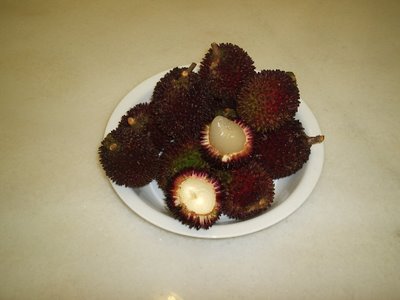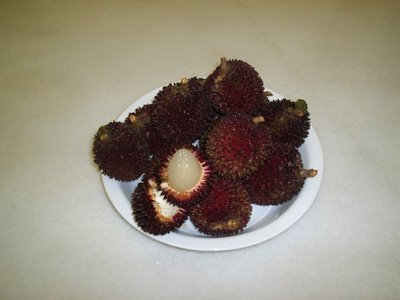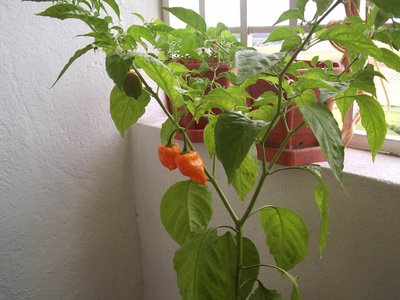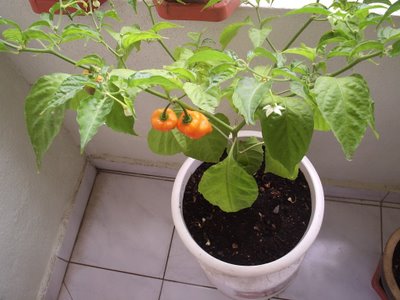I have been missing from blogging for 2 months again. As usual, bloggers will say that they are busy. It is true though. Looking deeper, it is all due to priorities. Every one of us has limited amount of time. When we decide to do something else first, we put it as priority numero uno, and de-prioritize blogging. Sometimes, we just take blogging for granted. We should be grateful that we still have this last frontier of freedom. Yeah! So, let's start blogging again.
Many people say that Malaysian is a plural society. However, we still remain separated and we don't actually understand each other cultures. There are many examples f0r this topic. However, there is one interesting practice by the Chinese Malaysian which I think, they don't even understand. When we were young, we were "trained" by many people that Buddhists do not eat beef. I was lucky that my father did not emphasize this kind of superstition on us. If you eat at a Malay "warong", "gerai", restaurant, or whatever, some of our Malay comrades who have less contact with the Chinese will look at you like you are an alien. Some will ask you in order to "double confirm" and explain to you specifically that the dish you ordered contains beef. Not too worry about this, but "Why the hell Malaysian Buddhists don't eat beef?"
To start with, many Chinese Malaysians who claimed to be Buddhists are not Buddhists. They are just "following" the Confucius teaching and mixing some of the Taoist rituals. However, the government just labels it as Buddhism. Surprisingly, many Chinese do not know how to differentiate too.
When you ask, people will tell you that it is because they pray to the deity Guan Yin. This is the simplest answer that you can get. Of course, it has multiple versions of legends associated with this statement. One version is that, the father of the deity Guan Yin was the "king of cows" and thus, it is a respect we show to deity Guan Yin. Some people come out with a standalone version where Buddhists respect cows for their contribution towards mankind. Cows supply milk to man, and do all the hard work in the field, etc.
Some people tried to linked this to the Indians who are mainly Hindus. As
Gautama Buddha, the founder of Buddhism was born a Hindu, abstinence from beef is a Hindu tradition that goes to China hand-in-hand with Buddhism. I thought it was
Bodhidharma who brought Buddhism to China. Anyway, this is not so important here because we are talking about Chinese Malaysians. If someone tries to link it to the Indian Malaysians who are predominantly from Tamil Nadu, it does not make sense too as the Chinese and Indians are separated by the British under the "divide-and-rule" strategy. The Chinese worked in tin mines while the Indians worked in rubber estates.
Chinese Malaysians will be surprised that out of Malaysia and Singapore, beef is always present in the menu in Japan, Korea, China, Taiwan, Hong Kong, and Vietnam. People in these countries practise Buddhism too. The Goddess of Compassion (Guan Shi Yin Pu Sha) is known as Kanzeon Bosatsu in Japan, Kwan Se Eum Bosal in Korea, and Quan The Am Bo Tat in Vietnam. On the other hand, food lovers know the Japanese Matsuzaka-Gyu (松坂牛) very well. You can see beef in sukiyaki, teppanyaki, shabu-shabu, etc.
Bulgogi is synonymous with Korean food, like
Kimchi. Needless to say, my favourite
Vietnamese beef noodle. So, "everyone" is eating beef, "What on earth is happening in Malaysia?"
This is just a speculation. Back in the days where the British took in loads of Chinese from mainland China to work in tin mines in Malaya, they might have planned this in advance. Due to the "divide-and-rule" policy, Malays, Chinese, and Indians were segregated to different industries and areas of residence. Since the Hindu Indians do not eat beef, they will not interact with the Malays when they need to buy meat. Indians and Chinese would not meet each other that much as the Chinese were mostly staying in towns and cities, while the Indians were mainly staying in rubber plantations. To ensure the Malays stayed away from the Chinese, it was important that the Chinese ate pork. As pig is "haram" in Islam, it would be easy for the British tell the Malays that these Chinese were unclean and eating "najis". Stay away from them!
Before the Chinese came to Malaya in big groups, there could be some or no pigs at all in Malaya. It will be easier for those to bring a pig with them on the boat than a cow. Once they were here, they started rearing pigs. Of course, pig rearers would encourage Chinese to eat pork. Otherwise, they would lose business. There was no turning back since then. Some people might cook up of a few excellent stories to keep Chinese from trying alternatives. Those local Chinese gangsters who usually involved in "associations" and "temples" might be responsible for those "don't-eat-beef" legends to keep their lucrative pork businesses. According to Kevin Hogan in his book, "
The Psychology of Persuasion", 85% of the people are conformist. When it comes to religion, it is really easy to "influence" people in the name of god or goddess.
Fast forward to today. One of the famous legacies from the pork eating culture in Malaysia is the
Bak Kut Teh, a Chinese Malaysian dish which you won't be able to find in China. I just guess that was how Chinese Malaysian evolve into eating pork and stay away from beef.









